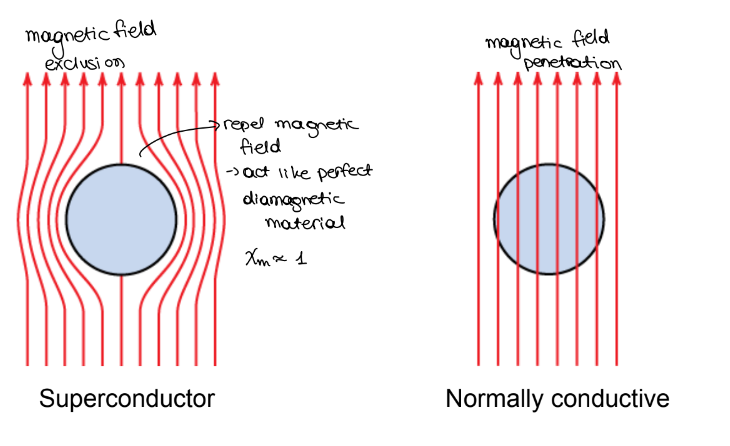MIE 270: Final (Part 2: Composite and Magnetic Materials)
1/40
Earn XP
Description and Tags
Chapters: 15 and 18 Does not include equations only theory
Name | Mastery | Learn | Test | Matching | Spaced |
|---|
No study sessions yet.
41 Terms
Composites
Multiphase materials
Composites: Matrix Phase + Dispersed Phase
Matrix helps retain shape and transfers stresses to the reinforcement
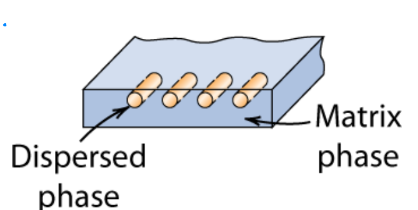
Matrix-based Classification
Polymer-matrix composites (PMC)
GFRP (Glass fiber)
CFRP (Carbon Fiber)
AFRP (Aramid Fiber)
Metal-matrix composites (MMC)
Ceramic-matrix composites (CMC)'
Carbon-Carbon composites
Hybrid Composites
Reinforcement-Based Classification
Particle - reinforced
Large (concrete)
Dispersion (TIny tiny)
Fiber - reinforced
Continuous aligned
discontinuous short
Aligned
Random
Structural
Laminate
Sandwich panels
Large-Particle Composites
Aggregate Size (water-cement)
both affect the strength of concrete
Problems
Very weak in tension
Thermal expansion
Water Permeability
Reinforced Concrete
Rebar/Wired Mesh
Fibers
Post-tensioning or Prestressing
Dispersion - Strengthened
Smaller particles
d = 10-100nm
Particles impede the movement of dislocations
Restrained plastic deformation
σy up, σts up, hardening up
Particles matrix interacuions
Strengthening at the atomic or molecular level
Example
Thorial (thorium dioxide) nickel-chromium, for thermal protection systems (TPS)
Fibre - Reinforced
Critical Fiber Length
L < Lc
Short Thick fibers
low, inefficient stress transmission
L > Lc
Long thin fibres
High Efficiency
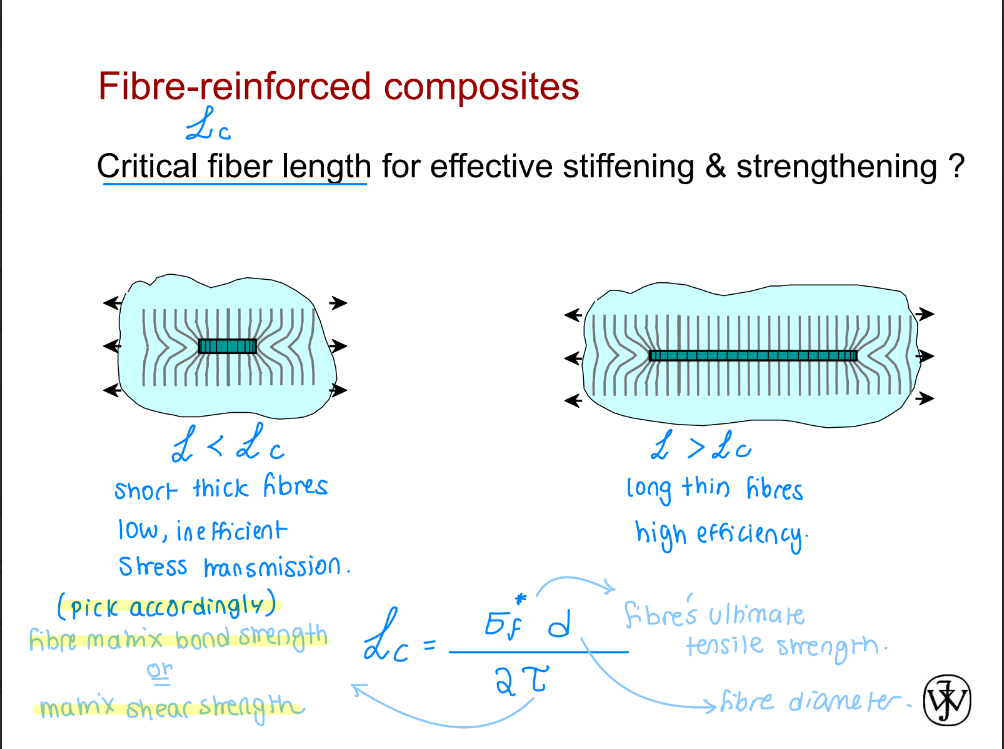
Pultrusion
Fibers pulled through a resin tank (thermosetting resin)
pass through a steel die performing to the desired shape
pass through curing die
machined to the final part
heated to cure resin

Prepreg - Sheets of a composite
—>
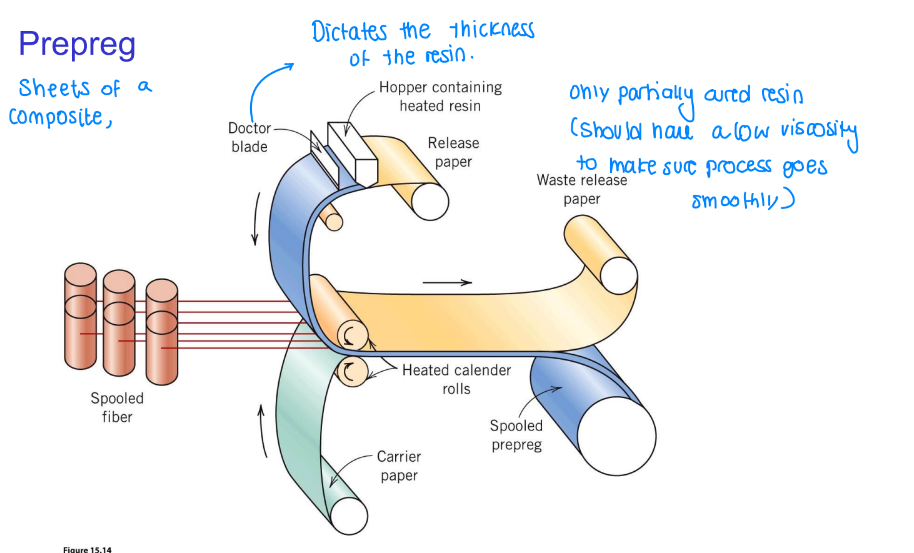
Filament Winding
Fibers are positioned in a predetermined pattern to form a hollow (usually cylindrical) shape.
Fibers are fed through a resin bath (thermosetting resin)
These fibers are then continuously wound onto a mandrel
After layering is complete, curing is carried in an oven or room temp
Mandrel is removed to give the final product
Con: Can’t get fibers to be longitudinal and is limited to closed convex shapes (cylindrical)
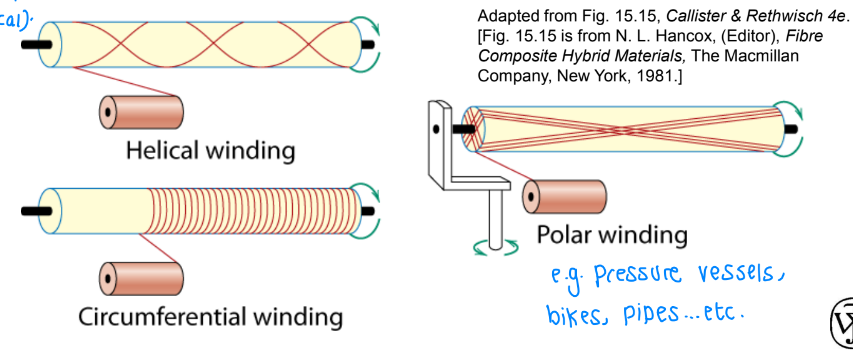
Laminates
Unidirectional: 0-degree angle between layers
notation: [0o]# of layers
Crossply: 0 then 90 angle between layers
[0o/90o]# of layers
Angle Ply: 45/-45
[45o/-45o]# of layers
Multidirectional:
[0o/90o/45o/-45o/]# of layers
![<ul><li><p>Unidirectional: 0-degree angle between layers</p><ul><li><p>notation: [0<sup>o</sup>]<sub># of layers</sub></p></li></ul></li><li><p>Crossply: 0 then 90 angle between layers</p><ul><li><p>[0<sup>o</sup>/90<sup>o</sup>]<sub># of layers</sub></p></li></ul></li><li><p>Angle Ply: 45/-45 </p><ul><li><p>[45<sup>o</sup>/-45<sup>o</sup>]<sub># of layers</sub></p></li></ul></li><li><p>Multidirectional:</p><ul><li><p>[0<sup>o</sup>/90<sup>o</sup>/45<sup>o</sup>/-45<sup>o</sup>/]<sub># of layers</sub></p></li></ul></li></ul>](https://knowt-user-attachments.s3.amazonaws.com/80ffcae8-b169-4748-be6c-8af7ccdd70d1.jpeg)
Sandwich Panels
The thickness of the core dictates the overall panel stiffness
With extremely large bending stiffness, it is lightweight and cost-effective
The purpose of the face sheets is to carry bending loads
The core
high shear strength of stiffness to withstand the transverse shear stress of buckling

Nanocomposites
Types:
Nanocarbon: can be single-wall carbon nanotubes
Carbon nanofibers
Nanolayers (layered silicates)
Particulate nanocrystals
Nanoparticle Size
decreasing size can eliminate magnetic properties
decreasing size, the surface/bulk ratio increases, and surface phenomena dominates
Applications
Increase in mechanical properties
Challenges
It is hard to achieve adequate dispersion
price
risk of toxic exposure
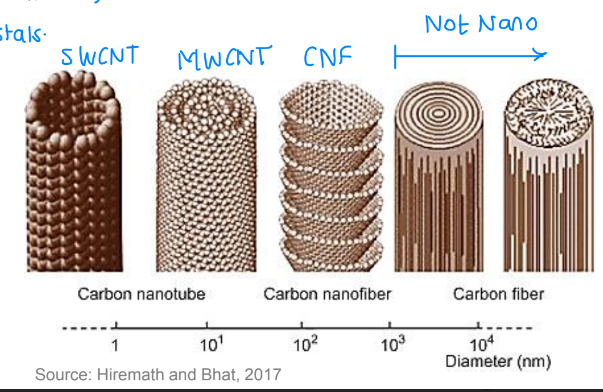
Magnetic Properties - Concept
To some extent, all materials are influenced by the presence of a magnetic field.
Magnetism: the ability of a material to exert attractive or repulsive forces on a material
Magnetic Forces
Generated by electrically charged particles
Electron Orbital motion
Electron Spin
Magnetic Field
Distribution shown by lines of forces
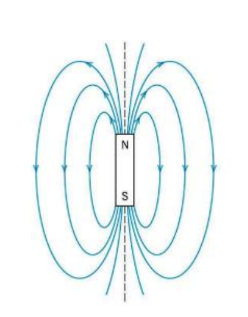
Magnetic Dipoles
Think of very tiny magnets that each have north and south poles
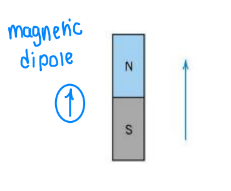
Magnetic induction
Applied Magnetic Field
Created by current through a coil
H
Externally applied magnetic field strength
B (Magnetic Flux density)
Is internally applied magnetic field due to the material inside the solenoid
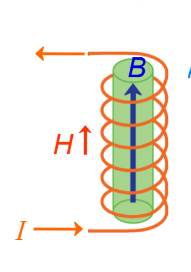
Permeability (mu)
measure of the degree to which a material can be magnetized
Magnetic Moment
As an electron movies in orbit it generates a magnetic moment. This magnetic moment is along the axis of rotation.
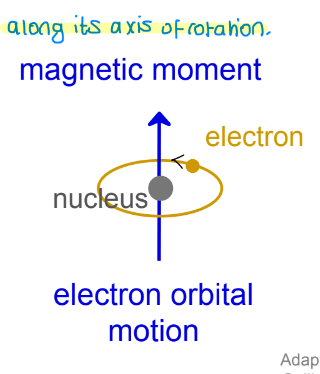
Electron spin
an inherent rotation or spin that electrons have, and it contributes to their overall magnetic properties. Denoted as mu s the magnetic moment is directed along the spin axis.

Net Atomic Magnetic Moment
Sum of all electrons (both spin and orbital)
Fundamental magnetic moment: Bohr Magneton
Types of Magnetism
Diamagnetic
Xm < 0
mur <= 1 (just below)
B < Bo
No Magnetic Dipole orbital
Paramagnetic
Xm > 0
mur >= 1
B > Bo
weak Magnetic Dipole spin
Ferromagnetic
Xm»0
mur»1
B = muoM M = Xr
Diamagnetic (Magnetic Responses)
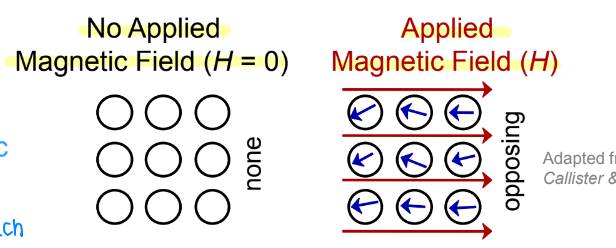
Paramagnetic (Magnetic Responses)
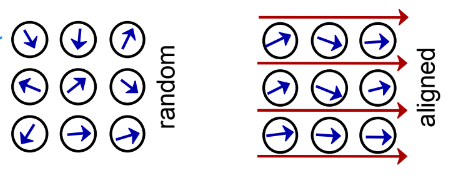
Ferromagnetic (Magnetic Responses)
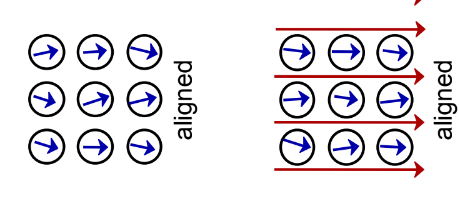
Diamagnetic Material
Have no unpaired electrons, hence magnetic moments are all canceled out
Weakly repelled by H
i.e. Au, Ag, Cu, Pb, water, humans, etc.
Paramagnetic Material
Have some unpaired electrons, hence magnetic moments are present
Weakly attracted by H
They lose their magnetization in the absence of a magnetic field
i.e., Al, Ca, Mg, Ti, etc.
Ferromagnetic Material
Spin of all electrons are parallel
Net(spin) magnetic moment
Coupling interactions: Magnetic moments of adjacent atoms to align
Domains: Mutual spin alignment happens over large volume regions
Strongly attracted by H
can be permanently Magnetized
Antiferromagnetic Material
Coupling between adjacent atoms and ions occur in other materials too, but not parallel
aligned in opposite directions, so that the moments cancel out
Material has no net magnetic moment
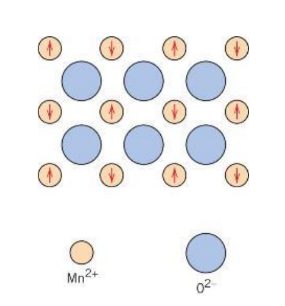
Ferrimagnetic Material
Cubic Ferrites (Fe3O4)
Some ceramics show permanent magnetization
non-parallel spin-coupling interactions
There is net magnetic moment since there is incomplete cancellation of the spin moments.
Good electrical insulators
Ms = Magnetic Saturation, Smaller than in ferromagnets
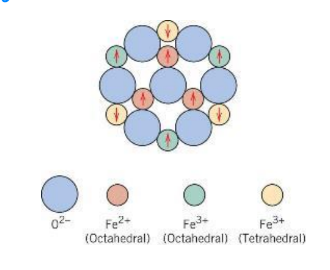
Magnetic Saturation
When you increase H beyond a level, increase in magnetization plateau
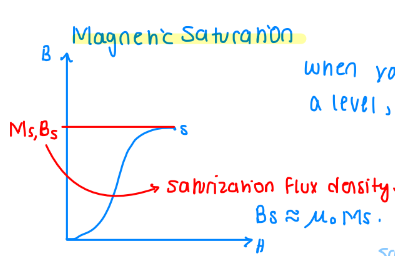
Domains in Ferro and Ferri-magnetic Materials
Before applied H
Mutual alignment of all magnetic dipole moments
After
At Ms , a single domain is oriented with H
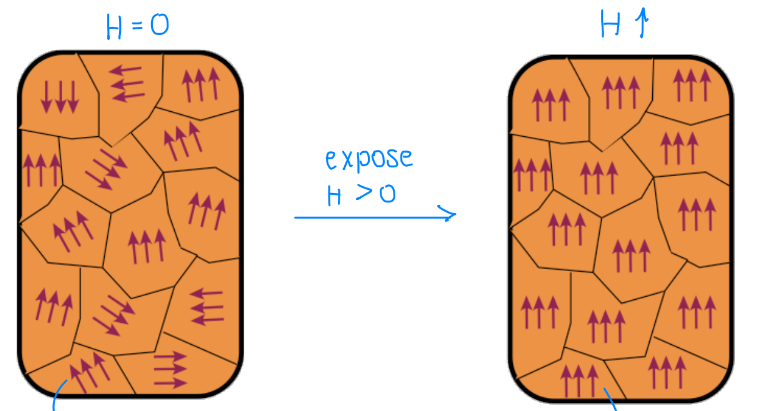
Magnetic Hysteresis
The tendency of a material to retain its magnetization even after the removal of an external magnetic field. It causes a lag between the changes in the applied magnetic field and the resulting magnetization.
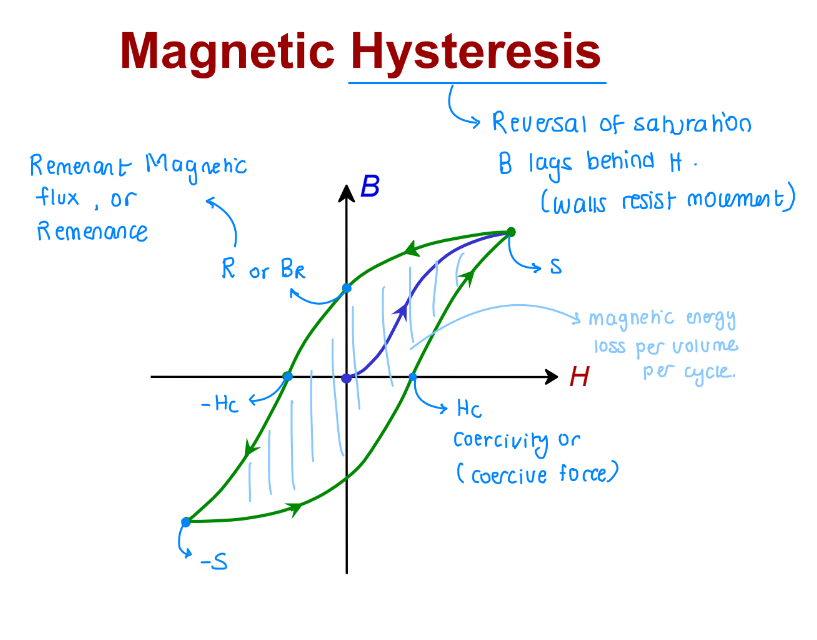
Soft Magnetic Materials
Low energy loss
High initial magnetic permeability
Low H conductivity
Can easily be magnetized and demagnetized with low energy loss
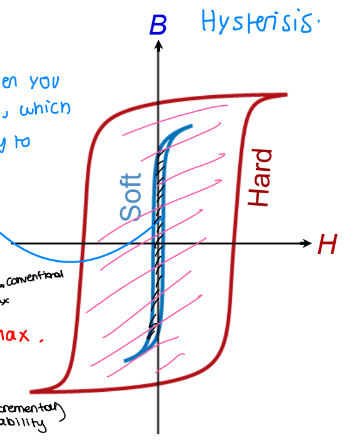
Hard Magnetic Materials
High energy loss
High resistance to demagnetization
Low magnetic permeability
High Hc, Br, Bs (Saturation magnetic flux density)
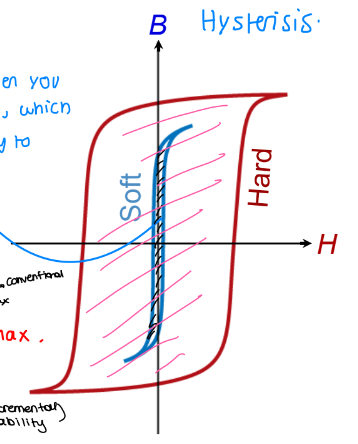
Effects of Temperature on Magnetic Properties 1
When temp increases, the magnitude of thermal vibrations of atoms increases, aligned directions turn to random directions and don’t get magnetized easily.
Ferro, AntiFerro, Ferri magnetic materials
Thermal motions counteract coupling forces between adjacent atoms or dipole moments causing dipole misalignment.
Ms is max when T = 0K
Effects of Temperature on Magnetic Properties 2
At Temp above Tc (curie)
Ferro and Ferri magnetic materials become paramagnetic
Tc (oC)
Fe 768
Co 1120
Ni 335
For antiferromagnetic materials
Tneel (equivalent to Tc)
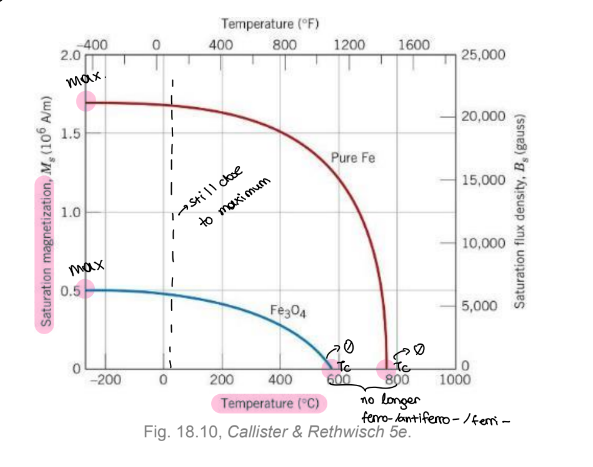
Magneto strictive
Magnetostrictive: A property of certain materials that exhibit a change in shape or dimensions when subjected to a magnetic field.
used as Sensors
Super Conductivity
The phenomenon where certain materials exhibit zero electrical resistance when cooled below a critical temperature, allowing for the efficient flow of electricity.
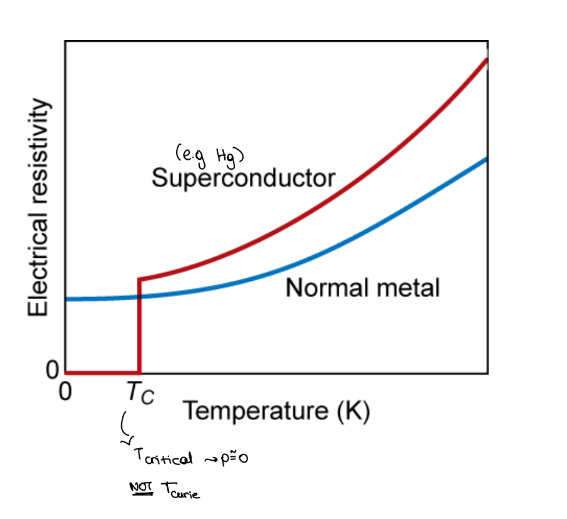
Meissner Effect
A phenomenon where a superconductor expels magnetic fields from its interior when cooled below its critical temperature, causing it to levitate above a magnet.
